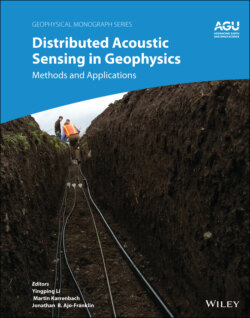Читать книгу Distributed Acoustic Sensing in Geophysics - Группа авторов - Страница 57
3.1. INTRODUCTION
ОглавлениеVarious fields, including seismic recording (Ni et al., 2002; Ni et al., 2005), resource exploration (Jagannathan et al., 2009), hydrocarbon production (Yamate et al., 2017), security surveillance (Harma et al., 2005), and subsurface structure imaging (Michaels et al., 2005), greatly rely on acoustic sensing or seismic survey techniques. These applications have promoted the development of long‐distance DAS technology. Specifically, a full well coverage downhole seismic array can be used to provide enhanced VSP imaging and monitor fluid and pressure changes in hydrocarbon production fields. High‐resolution reservoir structure imaging and time‐lapse reservoir monitoring provide us with critical information to guide the placement of production and water‐injection wells in high‐value reservoirs. However, the active and electrical characteristics of traditional downhole seismic sensors (geophones) limit the practical applications in harsh environments, such as high pressure and high temperature.
Compared to a traditional VSP survey using a downhole three‐component (3C) geophone array, the fiber optic DAS system (Jousset et al., 2018) uses only one single‐mode optical fiber to achieve the same objective as a downhole geophone array, which demodulates the acoustic signal acting on the long‐distance sensing fiber, through detecting the phase changes of the Rayleigh backscattering light from different positions along the fiber (Masoudi et al., 2013), to map the seismic signal distribution along the fiber. Because of the benefits of the passive sensing property, simple single‐mode fiber (SMF) configuration, light weight, and high adaptability to harsh environments, the fiber optic DAS system achieves signal “transferring” and “sensing” simultaneously in one fiber and then provides much more convenience for downhole deployment and operation. Particularly, massive information along the full borehole without any dead zone can be acquired by using the fiber optic DAS system.
Recently, the fiber optic DAS system is increasingly being recognized as an alternative to geophone arrays for the acquisition of borehole seismic data. Recording seismic data using the fiber optic DAS system instead of a downhole geophone array has distinct advantages, especially for VSP surveys. The fiber optic cable covers the entire well, and a full well VSP data can be recorded with a single shot. Wells can be retrofitted with fiber optic cables by clamping them on tubing (Follett et al., 2014), pumping them inside tubing (Mateeva et al., 2014), using hybrid fiber optic wireline cables inside the casing (Frignet & Hartog, 2014), or cementing outside the casing. Specifically, in wells with preexisting optical cables for temperature or pressure measurements, DAS on demand or time‐lapse VSPs can be acquired without well intervention (Mateeva et al., 2012, 2014). For practical applications, several researchers adopted the fiber optic DAS to realize an in‐well and geophysical monitoring. VSP data in two field trials in Canada and the United States were recorded from the entire length of wellhead to tubing design (TD) (up to 4 km) (Mestayer et al., 2011). Molenaar et al. (2012) reported an exploration and production downhole field trial of fiber optic DAS in a tight gas well. Daley et al. (2013) also utilized fiber optic DAS to realize subsurface seismic monitoring.
Most fiber optic DAS systems measure the phase change of Rayleigh backscattering light in the fiber to record the acoustic or seismic wave. Assisted with demodulation techniques, including optical coherent detection, 3 × 3 coupler detection, and phase‐generated carrier (PGC) detection, DAS systems based on optical time domain reflectometry (OTDR) and optical frequency domain reflectometry (OFDR) are constructed. Wang et al. (2015) proposed a novel fiber optic DAS technique based on phase extraction from a time‐gated fiber OFDR. The sensing distance reaches 40 km with a resolution of 3.5 m, and the dynamic signal with a frequency of up to 600 Hz is detectable. In 2017, He et al. (2017) realized a DAS with a multievent waveform recovery ability from 20 Hz to 25 kHz with a dual‐pulse phase OTDR. While the sensing distance is only about 400 m with a resolution of 20 m, the strain resolution is about 20 nε. Then, Chen et al. (2017) proposed a polarization‐independent fiber optic DAS along the 10‐km‐long fiber with a spatial resolution of 5 m, and specifically the strain resolution reaches 245 pε over 100 Hz. However, the noise floor in infrasonic range is much higher, which is ascribed to the weak and random Rayleigh backscattering light in the SMF (Martins et al., 2013). To enhance the SNR of the backscattering sensing light, a highly Ge‐doped fiber (Loranger et al., 2015), ultraviolet (UV) exposure of a hydrogen‐loaded fiber (Loranger et al., 2015), the lumped Rayleigh reflectors (Gabai et al., 2017), and FC/PC connectors (Loranger et al., 2015) inserted in the fiber have been demonstrated to be effective. However, these methods also increase transmission loss, obviously working against the long‐distance DAS. Hence, a novel sensing fiber with a high backscattering SNR and low transmission loss is desirable for the fiber optic DAS system. Moreover, the measurement resolution, response bandwidth, and long‐term stability still need to be further improved.
In this chapter, we propose and demonstrate a DMOF‐based ultrahigh sensitive DAS system and its applications in a borehole seismic survey. By introducing longitudinal microstructures as the local scatters along the fiber, the SNR of the backscattering light is greatly enhanced. Theoretical analysis proves that the sensing signal can keep stable both in time and spatial domains, ensuring high‐resolution and high‐stability measurement. Assisted by a coherent detection and differential sensing mechanism, a prototype of the DMOF‐DAS system is assembled. Experimental results with a wide frequency range from 0.01 Hz to 60 kHz and an ultrahigh strain resolution of 3.4 pε/√Hz around 10 Hz are achieved. Moreover, the field tests for VSP surveys demonstrate the excellent performance of the DMOF‐DAS system and great potential applications for borehole seismic surveys.
